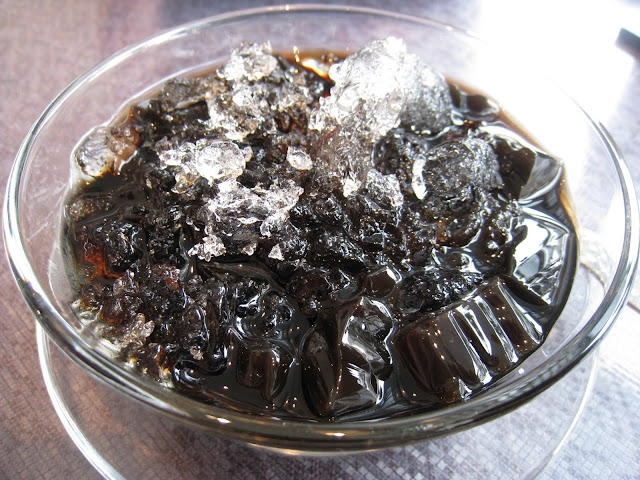Chaokuai
Chaokuai - grass jelly is often served with only shaved ice and brown sugar.
Chaokuai can be eaten in many ways to enhance its taste and make it more delicious. It is completely up to you on how you choose to have this dessert.
Khanom bua loi
Khanom bua loi – taro root mixed with flour into balls in coconut milk
This traditional dish is often prepared and eaten during festivals and special occasions. It is served in buffet with other desserts after the main course meal. You can add sweet corn kernels to the dessert and savor it just like some Thais love eating it. Traditionally, in Thailand the khanom bua loi is served with a syrup poached egg as topping for the dessert.
Khanom chan
Khanom chan – multi-layers of pandan-flavored sticky rice flour mixed with coconut milk.
Khanom chan is a delicious product of the thai cuisine. A well made khanom chan is sweet, which has made it a choice of even the most discrete palate. Khanom chan has become one of the most popular dessert around the world
Khanom mo kaeng
Khanom mo kaeng - a sweet baked pudding containing coconut milk, eggs, palm sugar and flour, sprinkled with sweet fried onions.
Kha-nom Mo Gaeng is one of our famous Thai dessert. Maybe you have a question why Thai people choose palm sugar for all kind of food, especially when we cook Thai dessert. Palm sugar has a nice color and odor, and of course its unique taste with high cholesterol.
No wonder I am getting fat!
Khanom tan
Khanom thuai talai' - steamed sweet coconut jelly and cream.
Khanom thuai talai is prepared by steaming. It is generally regarded dessert. It is well liked among those who love sweet food. Khanom thuai talai comes under the class of thai foods.
Khao niao mamuang
Khao niao mamuang - sticky rice cooked in sweetened thick coconut milk, served with slices of ripe mango.
This luscious dessert is a form of rice pudding that is paired with mangos at the peak of their ripeness. Sweet and rich, khao niao mamuang is a favorite way to finish any Thai meal.
Lot chong nam kathi
Lot chong nam kathi – pandan flavored rice flour noodles in coconut milk, similar to the Indonesian cendol.
Popularly known as a thai food, lot chong nam kathi, eaten as dessert, is popular in many different cuisines across the world. It is an item of choice for those who prefer sweet foods.
Ruam mit
Ruam mit – mixed ingredients, such as chestnuts covered in flour, jackfruit, lotus root, tapioca, and lot chong, in coconut milk.
Ruam Mit in local parlance means ‘social cohesion of diverse elements’, and true to its name, Thai’s exclusive dessert upholds the meaning of Ruam Mit in all possible ways.
Before we step into the techniques of how to eat Ruam Mit, lets explore what are the ingredients which make up this sweet Thai delicacy and how to relish it, as an experience to cherish?
Ruam Mit mainly comprises jackfruit(fruit of the mulberry family), flour-coated chestnuts, lotus root, tapioca and lot chong(pandan-flavored rice noodles) in a bath of coconut milk, and the aroma of jasmine.
Sarim
Sarim – multi-colored mung bean flour noodles in sweetened coconut milk served with crushed ice.
Sangkhaya fak thong
Sangkhaya fak thong - egg and coconut custard served with pumpkin, similar to the coconut jam of Malaysia, Indonesia and the Philippines
A Thai Pumpkin Custard. I'm sure if you cook this menu for dessert maybe for dinner. Your weight will go higher and higher. I rarely eat this menu because I think this is very luscious but the curd of custard is very fantastic too. So I suggest you eat this per month. It's worth to eat more that worried about your weight.
Tako
Tako - jasmine scented coconut pudding set in cups of fragrant pandanus leaf.
The Thai pudding of tako comes with a delicious topping of creamy coconut. And, the best thing about this delicious pudding is that, it’s so smooth that you don’t even have to exercise your teeth much to chew it. The scent of the coconut garnished at the top of the pudding, makes the dessert all the more appetizing.
 RSS Feed
RSS Feed
 Twitter
Twitter



%5B1%5D.jpg)


 12:03 PM
12:03 PM
 Skutt Panda PO
Skutt Panda PO




.jpg)





%5B1%5D.jpg)

































![Validate my RSS feed [Valid RSS]](http://feedvalidator.org/images/valid-rss-rogers.png)